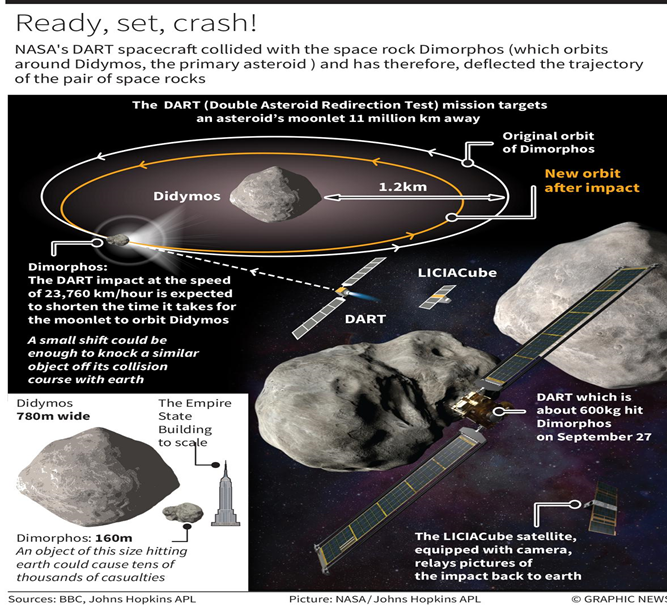In News:
- A National Aeronautics and Space Administration (NASA) spacecraft recently rammed an asteroid at lightning speed in an unprecedented trial run for the day when a killer rock threatens Earth.
- The DART (Double Asteroid Redirection Test) spacecraft collided with the space rock Dimorphos.
What’s in today’s article:
- About the NASA’s mission
- Significance of this mission
About the NASA’s mission:

- Double Asteroid Redirection Test (DART) is a NASA space mission aimed at testing a method of planetary defence against near-Earth objects (NEOs).
- It is the first-ever mission dedicated to investigating and demonstrating one method of asteroid deflection by changing an asteroid’s motion in space through kinetic impact.
- An asteroid is a minor planet of the inner Solar System.
- Asteroids range in size and shape from 1-metre rocks to a dwarf planet nearly 1000 km in diameter.
- They are metallic or rocky bodies with no atmosphere.
- The auto-rickshaw sized 600 kgs probe - DART, was launched from Earth in 2021, and it recently collided with football stadium-sized Dimorphos (about five billion kgs in mass), orbiting around the 780 metres wide primary asteroid Didymos (which poses no actual threat to Earth).
- NASA has confirmed that the collision deflected the pair of space rocks' trajectory.
- This method of kinetic impact is also known as the 'kick'
- DART is a joint project between NASA and the Johns Hopkins Applied Physics Laboratory (APL), Maryland, US.
- International partners include the European Space Agency (ESA), the Italian Space Agency (ASI), and the Japan Aerospace Exploration Agency (JAXA), contributing to related or subsequent projects.
Significance of this mission:
- It may one day save humanity from a potentially catastrophic collision by safely deflecting a deadly asteroid on its way to Earth.
- For example, following NASA's lead, China plans to deflect 2020 PN1 in 2026 - a 40m diameter earth-crossing asteroid.
- It could also fuel space mining technologies and kickstart the space economy in the coming decades.
- The ‘kick’ technique that deflects asteroids can then be used to move a small asteroid into a convenient position for space mining.
- Rare earth elements such as yttrium, niobium, rhodium, palladium, osmium, iridium and scandium are critical for developing green energy technologies such as electric vehicles, solar panels, wind turbines, etc., ushering a low carbon economy in the future.
- Mining for rare earth elements has a high environmental cost and they are in short supply.
- Penalties for pollution may make space mining economically viable in the coming years.
- NASA's Asteroid Redirect Mission (ARM), which has been axed, aimed at bringing a 20-tonne space rock close to Earth for study and mining.
- In some ways, the DART mission is also included in this frame.









